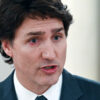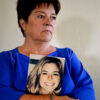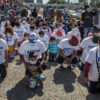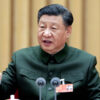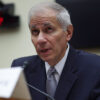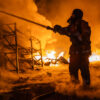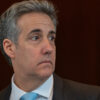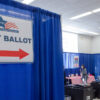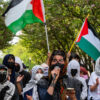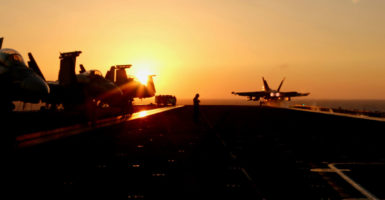USS GEORGE H.W. BUSH, Mediterranean Sea—The sound of aircraft launching off the flight deck rumble deep within the bowels of the aircraft carrier.
Conversations in the officers’ mess room, where I’m having chicken cacciatore for lunch, dutifully pause while the jet engines above decks run up to full afterburner. Then, the walls and floor shudder when the steam-powered catapults launch the F/A-18 Hornet and Super Hornet strike fighters and the EA-18G Growler electronic warfare jets off the flight deck at an acceleration of zero to 184 miles per hour in just two seconds.
Just by the sound of it, there’s no way of knowing if each successive launch is for combat or for training. But there’s a good chance the jet you hear is headed to war.
Each day about 16 to 24 sorties launch from the USS George H.W. Bush en route to Iraq and Syria to support a nearly 3-year-old coalition air war against the Islamic State, the terrorist group also known as ISIS, called Operation Inherent Resolve.
On this day, as I intermix eating and interviewing, I’m sitting across the table from an F/A-18 Super Hornet fighter pilot from Strike Fighter Squadron 87 (VFA-87), a Navy lieutenant who goes by the call sign “Bacon.”
I ask the pilot how he defines success.
“Validation of all my years of training is my measure of success,” Bacon replies.
Bacon, who asks that his full name not be used due to security concerns, is trim, articulate, and effusively polite. He sports a mustache, which matches his reddish hair. The mustache is a tradition among male pilots on combat deployments. The Air Force does it, too.
If Bacon wasn’t in his flight suit, however, he would look like any young American man. There would be nothing to outwardly imply that he is among the most well-trained and lethal warriors in history.
I’m about to ask Bacon another question, the one I really want to ask. But, before I can get the words out, there’s the roar of afterburners, and the whole room shakes as another jet launches. Bacon smiles, points his eyes to the ceiling, and patiently waits for the noise to subside and for me to continue.
The thud of the catapult, the roar of take off. Then quiet. It’s my cue.
“OK, let’s keep going,” I say. Bacon leans forward, whether feigning interest or being genuinely polite, I can’t tell. I imagine talking to a journalist is not on his list of most desirable activities in between combat missions. It wouldn’t have been for me. But he deals with it in an exceedingly polished way.
“You’ve seen the ISIS snuff videos,” I go on. “How they burned alive the Jordanian F-16 pilot [1st Lt. Muath al-Kasasbeh], and how they’ve beheaded foreign journalists like James Foley, who was my friend.”
Bacon nods.
“Does the brutality of ISIS affect you?” I ask. “Does it make it easier to kill?”
I ask the question cautiously, almost embarrassed at the words. I’m worried that my budding civilian perspective is overdramatizing the war in the way civilians are so prone to do. War becomes much less romantic, or epic, when you’re in the arena every day, away from your family and friends for months on end—not for a few days or weeks at a time as us journalists typically are when we embed.
I assume that for these operators, who have endured years of intense training to be where they are, the war is a daily task to be executed cleanly and professionally, without much thought devoted to its overall moral justice. Surely, I think, pilots like Bacon have achieved a requisite degree of mental detachment from the killing they do.
I was wrong.
At the end of my question, without a moment’s pause to craft a response, as if he had thought of his reply long before I had even asked the question, Bacon answers, “After Sinjar, their actions justified our response.”
He’s referring to Islamic State’s genocide of Yazidis, Christians, and Shia Muslims in the Iraqi town of Sinjar. There, in August 2014, ISIS killed about 5,000 people—including men, women, and children. The militants mostly spared the young women for use as sex slaves. When I visited Sinjar in June 2016, none of its 88,000 civilian residents from before the war were left living there. They had all become refugees, or had been killed or enslaved by ISIS.
Sinjar was one of the key events that spurred the U.S to begin airstrikes against the Islamic State. The murder of Foley was another.
Bacon’s words are measured and low-key as he talks about the Islamic State’s barbarism. No machismo or posturing. And certainly no canned responses dictated by the brass. Only a blunt declaration that hints at what lies inside the warrior’s mind.
“I’ll happily take the fight to the enemy, rather than them taking the fight to us,” Bacon says. “That’s mission accomplished.”
Momentum
Bacon is on his second combat deployment to support Operation Inherent Resolve. He and his fellow combat aviators aboard the USS George H.W. Bush are responsible for killing the enemy and protecting innocent lives each time they fly into Syria and Iraq.
Of course, the pilots’ lives hang in the balance of each mission, too. A single mistake during the risky routine of carrier flight operations can be fatal. And there’s danger over the Syrian war zone, where Russian and Syrian warplanes operate in narrowing proximity to U.S. forces.
There’s also a surface-to-air threat from the Syrian regime, the likes of which U.S. pilots have rarely faced, if at all, in the past 16 years of supporting post-9/11 counterinsurgency campaigns in Iraq and Afghanistan.
The air war over Syria, consequently, is one of the most complex in which active-duty U.S. Navy aviators have ever flown. Yet, despite the war’s complications, the effects of air power have been a bane to the Islamic State and a boon to U.S. partner ground forces like the Kurdish peshmerga, the Iraqi military, and the Syrian Democratic Forces.
Coalition air power has given America’s ground partners the battlefield momentum they need to put the Islamic State on its heels. The terrorists’ stronghold of Mosul in northern Iraq has fallen. And the Islamic State’s de facto capital of Raqqa is under siege.
As coalition partner ground forces circle in for the kill, the Islamic State’s leaders are decamping south along the Euphrates River valley into some of the last towns they still occupy, like Tal Afar in Iraq and Deir al-Zour in Syria.
The Islamic State now holds only one-third the territory it did in 2014 at the height of its strength. About 60,000 of the terrorist army’s fighters have died in combat since Operation Inherent Resolve began in 2014, according to U.S. officials. In 2015, the Islamic State was able to offset its battlefield losses with new recruits. Now, recruitment has slowed to a trickle as the militants’ losses continue to mount.
“We definitely have the momentum,” Bacon tells me. “Now ISIS has to find one spot and hold on to it. Everything has been building up to this.”
Compartmentalization
Emotional compartmentalization is an essential skill for the military aviator. The high-stress environment of combat aviation leaves little time to reflect on its life or death consequences.
It can be the same with landing—especially on a carrier. The pilot’s job requires so much focus, and is so reliant on habit patterns ingrained through years of training, that the brain goes into triage, discarding sensory inputs not immediately necessary to the task at hand. That’s why the landing gear handle is shaped like a wheel, blinks red, and blares an audible warning when it’s time to lower the wheels. Smells, sounds, even your peripheral vision can incrementally shut down as you tap into every available neuron in a high-stress situation.
Emotions switch off, too.
Short story: When s— hits the fan, you’re too busy to be scared.
Before my lunch with Bacon, I visit the squadron briefing room for Strike Fighter Squadron 87 (VFA-87), an F/A-18 Super Hornet squadron deployed on the George H.W. Bush.

One key challenge for Navy commanders is to connect the day-to-day duties of sailors with the war they never see.
Inside the VFA-87 squadron room, in which rows of leather, La-Z-Boy-style chairs are arranged like in a movie theater, the pilots laugh, joke, watch movies, and munch on snacks during downtime.
In the briefing area, a metal bolt hangs from a string above the assigned seat of a pilot who botched a recent landing. Humor and good-natured ribbing are essential components of fighter pilot culture. The hidden meaning behind call signs, for example, is usually related to some act of buffoonery committed by the named pilot.
If the pilots’ behavior seems incongruous with the high stakes of their profession, it’s because they purposefully act that way to endure a level of stress most humans could never endure.
The joking, the cool demeanor, the compartmentalization, the sterile vocabulary—to an outside observer those things might seem like the collective symptoms of emotional indifference.
But it’s all part of a well-honed culture among combat aviators, which ingrains in them the necessary mental resilience to deal with the crushing stresses of combat aviation.
“We call it compartmentalization,” Lt. Cmdr. Scott Welles, call sign “Butters,” an F/A-18 Hornet pilot with Strike Fighter Squadron 37 (VFA-37), tells me.
Sometimes, news reports and Hollywood movies depict combat aviation as an emotionally vapid experience. But U.S. military aviators—both the pilots and weapons systems operators—are not emotionless automatons blindly executing orders.
By its very nature, combat aviation is removed from the tragedy and carnage of the battlefield. Today, as it was for the American fighter pilots who first saw combat over the World War I trenches in France a century ago, U.S. combat aviators—both the pilots and weapons systems operators—live in relative safety distant from the front lines.
Yes, the pilots are physically removed from the battlefield, but they are not insulated from the moral imperative of their actions. The Islamic State’s snuff videos, which may be a slick recruitment tool for aspiring extremists, also harden U.S. combat aviators to killing their enemies.

Coalition air power has put the Islamic State on its heels. The terrorist group has about 60,000 fighters in combat since 2014.
“Does Islamic State’s brutality give your mission an added sense of purpose?” I ask Lt. Brandon Rogers, call sign “Barf,” an F/A-18 Super Hornet pilot from VFA-87. “Does it make it easier to kill?”
“Yeah,” Rogers replies, “the whole purpose is … to protect those who can’t protect themselves. Every single mission that you go on, you realize that it’s one step closer to protecting our way of life.”
Rogers, like Bacon, has a deployment mustache in the works. He nods politely as I ask my questions.
“In this environment, it’s much more kinetic” than previous deployments to Iraq and Afghanistan, Rogers tells me. Meaning, U.S. warplanes are dropping more bombs.
Rogers enlisted in the Navy in the wake of the Sept. 11, 2001, terrorist attacks. He deployed twice as a gunner’s mate, and has been a pilot for 10 years now. He’s on his fifth overall deployment—the fourth in support of combat operations.
“How do you define success?” I ask.
“A reduction in ISIS numbers,” Rogers says. “To continue to keep them down until somebody else can take over and make sure that they can never rise again. That is my idea of success. If I can play a part in it, then that’s fantastic.”
‘Thugs’
In May 2015, ISIS released a list of the names and addresses of about 100 U.S. military pilots. Consequently, Navy aviators and sailors won’t talk to the media about their families. Some, like Bacon, choose not to give their names out at all.
For many, the Islamic State’s “pilot’s list,” as it’s known, made the war personal.
“What I’ve learned, is that I wouldn’t pick on America,” Capt. James A. McCall, commander of Carrier Air Wing Eight, tells me during an interview in his office aboard the George H.W. Bush.
“Because we’re gonna come find you,” McCall continues. “And I think that’s independent of politics, administrations. I think that’s our American nature. If you threaten our families, our way of life, then we’ll go to no end to ensure that’s not going to happen.”
McCall, a 1993 Naval Academy graduate, is in charge of the 74 aircraft embarked on Carrier Strike Group Two. His responsibilities are expansive, ranging from combat missions over Syria to patrolling the eastern Mediterranean Sea for Russian submarines.
An F/A-18F Super Hornet weapons system officer and a Navy Fighter Weapons School (TOPGUN) graduate, McCall is a consummate professional, whose answers to my questions are articulate and to the point. Yet, at the mention of the Islamic State’s brutality and the “pilot’s list,” McCall bares his emotions.
“You have an organization that’s made threats against Americans and their families,” McCall says. “ISIS, this band of thugs and terrorists have decided to take parts of two countries and call it their own, murdering innocent civilians, women, and children along the way, very publicly, very graphically, and basically promoting an ideology that is incompatible with human life of any sort around the globe.”
“It’s that kind of indiscriminate violence that brought us here,” he adds. “And that’s incompatible with the American way of life, and incompatible with what I would say is civilized life around the world. That’s why we’re here.”
The Impossible
To an outside observer, flight deck operations look like chaos. But, truly, it is an unparalleled display of teamwork, efficiency, and measured professionalism in performing “the most dangerous job in the world.”
For a newbie to a carrier flight deck like myself, you feel totally overwhelmed. First of all, it’s uncomfortable. You have to wear pants and long sleeves to protect from the furnace blast of jet exhaust, through which you frequently pass as planes taxi around. With noise-cancelling headphones over your ears, the jet noise is dulled, but so are shouted warnings. A helmet and facemask protect your eyes, but also constrict your peripheral vision.
The protective gear limits your situational awareness, so you have to anticipate where the danger is. It’s all too easy to step in front of a moving aircraft, or get sucked into a jet engine. I’m not too proud to admit that it took a few well-timed tugs on my elbow by crew members to avoid a misstep, or disaster.
Launches are awesome, especially at night. The twin afterburners illuminate like giant blowtorches as the plane, which is shackled to the catapult shuttle, leans forward and down into its landing gear against the bridled thrust. You feel the sound in your chest it’s so loud. When the catapult goes, the warplane rockets away at what seems to be an impossible rate of acceleration. As the jet flies away and the noise fades you realize you’re laughing like a little kid on a roller coaster.
The returning jets scream over the deck in formation before they break into the traffic pattern. You can see them circling the ship out in the distance. When each jet lines up aft of the vessel on final, it seems to hang, suspended in space, edging toward the flight deck. The steepness of final approach becomes clearer as the jet nears. And then, as if the last few moments are in fast forward, the warplane is upon the ship. It cuts down fast, lands hard. The engines spool up to full power, giving the aircraft enough propulsion to take off again if the tailhook fails to catch the arresting wires.
You stand behind a painted line at the edge of the landing area. Every time a plane lands it seems like it will roll right into where you are. A tingle down the spine that tells you you’re in the wrong spot. The jet can’t possibly stop in so short a distance—can it?
But it all happens as it’s supposed to. The tailhook catches, and the plane decelerates from 155 miles per hour to a full stop in about 320 feet.
Free of the arresting wire, the jet’s wings fold up as it taxies free of the landing area. The next plane on approach comes into focus behind the ship. Again, it looks impossible. Again, it all happens as it’s supposed to.
On a carrier flight deck, the exceptional, borderline unbelievable, is routine.
Links in the Chain
Down in the George H.W. Bush’s hangar bay you’ll find the behind-the-scenes work that keeps the Navy’s air war against ISIS running. Maintainers, in green shirts, toil away, for 12, 13, 14 hours a day. They clean, polish, test, repair, and inspect the myriad parts and systems of each multimillion-dollar warplane. Heady stuff for crew members who are mostly in the front half of their 20s.
Rock music blares from speakers, interrupted from time to time by announcements over the ship’s PA system. One corner of the hangar bay has been converted into a CrossFit workout area.
An aircraft elevator descends from the flight deck above, bringing an F/A-18 Super Hornet strike fighter with it. The jet’s nose points inboard, its sleek form is silhouetted against the horizon line dividing the dark blue sea from the light blue sky. The wave tops in the background zip by. Inside the hangar bay, however, it’s easy to forget you’re on a 1,092-foot-long ship cruising at nearly 30 miles per hour.
It’s also easy to forget, as an outside observer, that this is a ship at war.
As you stand watching the aircraft elevator descend, nearby crew members in red shirts wheel a laser-guided bomb on a cart past a team of maintainers changing out an engine on a Super Hornet.
The combat workload required of the jets is merciless, so too is the effort required to keep them operational. The consequences for failure are unthinkable. The immolation of al-Kasasbeh, the Jordanian F-16 pilot whose jet went down over ISIS territory due to a mechanical failure, looms as an ominous reminder of what’s at stake.
ISIS captured al-Kasasbeh, then burned him alive in a cage. The terror group posted a snuff film of the execution online.
No Navy maintainer wants to let that happen to any of their pilots. There’s no room for failure on this mission. There never is, really, on an aircraft carrier conducting flight operations at sea. But this time, the stakes are even higher.
I chat with Aviation Machinist’s Mate Petty Officer 3rd Class Richmond while he performs maintenance on an EA-18G Growler. (Richmond asks that his first name not be published due to security concerns.)
The Growler has the same airframe as the Super Hornet, but is equipped with electronic warfare weapons rather than kinetic ones. Richmond, who is 23 years old, has removed a section of panels from the jet’s exterior to clean and inspect the inner structure of the aircraft for wear and tear. He scours the engine compartment, scraping away oil and fuel residue that has built up over time.
Sweat beads on Richmond’s forehead. His long-sleeve green shirt is smeared with grease. It’s just another 12- to 13-hour workday.
We talk for a bit about his job and life on board the carrier. Then I ask Richmond what I’ve been asking the pilots: “Do you think about the war, or about the savagery of ISIS, when you do your job?”
“I mean, I don’t really think about the bombs as much because our jet does a completely different mission,” Richmond says.
“It’s an electronic attack jet, so it jams radars,” he continues. “Anything from cellphone signals, to radars, to anything that can trigger a signal on the ground. And it jams everything all at once … But when you see the jet and it has the lightning bolts [painted] on it, it’s, in a sense, kinda cool because we’re doing something that all these other jets can’t do. So it’s nice to think about. Well, in a sense we’re like the protector of all these jets.”
One key challenge for Navy commanders is to connect the day-to-day duties of sailors with the war they never see.
“Our asymmetric advantage is our people,” Rear Adm. Kenneth Whitesell tells me later, during an interview in his office on the George H.W. Bush.
Whitesell, a Virginia native, is commander of Carrier Strike Group Two. As we talk, he lays out a map of the eastern Mediterranean, Syria, and Iraq on a coffee table. He uses a blue highlighter to show me the two different routes U.S. Navy warplanes take into the warzone—one through Turkey, and another through Syria and Jordan.
He also circles areas where Russian and Iranian ground forces operate.
“We assume that the Russians are advising the Syrians on what to do,” Whitesell tells me. “The Syrians have not gone into any offensive mode against us when we fly over Syria … they have not alerted their surface-to-air missile sites. They’ve allowed us to fly over the top of their airspace, and I think that’s significant because of the Russian influence over them.”
As we talk, a TV in the background plays a live black-and-white feed of flight deck operations. I ask Whitesell about the importance of educating crew members on their role in the overall war effort.
“Everybody here has a critical role they play,” he says. “We move an individual out of their personal link, remove their link out of the chain, then somebody else has to step up and do their job. So when we talk to the kids, we explain to them that chain link scenario, and how important they are. If they do their job—they don’t have to be a superhuman—but if they do their job, then they maintain the strength of our link in the Navy.”
Earlier, back in the hangar bay, Gunner’s Mate Petty Officer 3rd Class Yates stands beside quietly as Richmond explains the combat role of the Growler. Yates is 20 years old and works in the Deck Department, which is responsible for the safety of the ship and crew. Like Richmond, she asks that only her last name be published.
I ask Yates about her daily work schedule, and what it’s like to be away from home for so long. And then I segue into my familiar refrain: “Do you think about the bigger picture? Do you think about the enemy and what’s at stake?”
“I mean, I think about it all the time,” she replies. “We’re going through our daily paces, while the pilots are dropping these bombs. It kind of brings a bigger picture into your head. You actually start realizing what you’re doing. It feels good knowing that we’re helping people out, doing the things that we have to do in order for everyone to be safe.”
‘A Truly Great Feeling’
Each crew member has his or her personal reasons for serving. For 28-year-old Lt. Lada Kukuy, an intelligence officer, her parents played a particularly pivotal role.
We chat over lunch in an officers’ mess hall aboard the USS George H.W. Bush. With short-cropped hair, emotive eyes, and a persistent smile, Kukuy is ebullient, both about her reasons for military service as well as about the history and contemporary affairs of the country in which she was born—Ukraine.
Kukuy leans forward and nods approvingly as I talk about the front lines in Ukraine before shifting gears into questions about her life and why she chose to serve in the Navy.
As is the norm during flight operations, we have to pause from time to time as warplanes launch every minute or so from the catapults a few decks above us.

“It is a truly great feeling giving back to the country I love,” 28-year-old Lt. Lada Kukuy, an intelligence officer, says.
Kukuy hails from Brooklyn, but she was born in the Ukrainian city of Dnipro. In 1997, when she was 8 years old, Kukuy’s parents decided to move to America for a better life. Her father had always quietly resisted the Soviet regime, Kukuy says, and had admired the United States.
He’s also a fan of the Navy. Like most young men in the Soviet Union, Kukuy’s father was required to serve in the Soviet military. At that time, the navy was the most selective branch of service in the Soviet Union.
“My dad was always fascinated with the Navy,” Kukuy says. “He couldn’t serve in the U.S., but he was still passionate for all things naval.”
After immigrating to America, Kukuy’s father passed down his passion for the Navy to his daughter, taking her to air shows and fleet weeks in New York City. So, when a naval recruitment office opened up in Kukuy’s hometown around the time she was choosing a career, her future crystallized.
“With my dad’s support, I went for it,” she says.
Kukuy, who still speaks fluent Russian and some Ukrainian, attended Boston University for her bachelor’s degree, and earned her naval officer’s commission through ROTC. She is the first woman in her family to serve in the military.
“My parents are very patriotic,” she says. “They had no regrets for moving to the U.S.A., even in the darkest of times.”
Kukuy said she always came back from her visits to Ukraine with “a widened appreciation for what I have.” But Ukraine’s ongoing fight for its democratic future free from Russian influence, which Kukuy has watched from afar, has given the 28-year-old Navy lieutenant an appreciation for life in the U.S. elusive to many Americans who have never experienced the alternative.
“It is a truly great feeling giving back to the country I love,” Kukuy says.
The Sound of God
Back in the mess room, as Bacon and I wrap up our interview and shake hands goodbye, I tell him something personal, which I told all the pilots during my short stint aboard the George H.W. Bush.
Near sunset one evening in the summer of 2016, I was on the rooftop of a Kurdish peshmerga fort in the front-line town of Gwer, on the south side of Mosul. I stood behind a sand bag berm beside Gen. Omar Hama Ali Farag and watched through binoculars as ISIS fighters scurried between their positions a mile away across a dry riverbed that was no man’s land. The terrorists looked like distant rats in their all-black garb and frenetic movements.
Then, we heard the sound of warplanes. Distantly above, I could see the arrowhead shape of two jets scorching across the clear, dark blue sky.
“That’s the sound of God,” the old peshmerga general told me.
Farag, like many older Kurdish soldiers, had survived Saddam Hussein’s al-Anfal genocide in the late 1980s, when the Iraqi dictator killed more than 180,000 Kurds in a bombing campaign that included the widespread use of chemical weapons. The sounds of jet engines had, thereafter, stirred remembered terror among the Kurds who survived Saddam’s chemical weapons attacks.
“Now the sound of the planes makes me happy,” Farag told me as we watched ISIS fighters die. “I can’t explain how important the U.S. planes are for us. If we can’t hear the sound of the planes, we can’t stay here and fight.”
“Damn, I’ve got goose bumps,” Bacon says after my story. But the look on his face says more. A big smile curls that red mustache from end to end.
The peshmerga may call the snarl of U.S. jet engines the sound of God, but the American aviators behind the controls of those warplanes have wholly human reasons for going to war.
“You’re making a difference,” I tell Bacon. “You’ve saved a lot of lives, and America has friends forever for what you’ve done.”
Now, I won’t say Bacon teared up, but the light might have reflected off his eyes a little differently.
“That’s awesome to hear,” the Navy strike fighter pilot says. “Really awesome to hear.”




